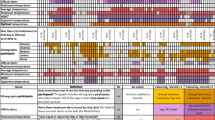Summary
The effects of various convective and temperature regimes on heat production, evaporative heat loss, and thermal resistance were studied in deer mice,Peromyscus maniculatus. Heat production (measured as oxygen consumption) increased with increasing wind speed (V) and decreasing ambient temperature (T a), except atT a=35°C which was thermoneutral for allV from 0.05 through 3.75 m/s. Evaporative water loss (\(\dot V_{\operatorname{H} _2 \operatorname{O} } \)) increased with increasingT a, but wind had little effect on\(\dot V_{\operatorname{H} _2 \operatorname{O} } \) except at highT a. In the absence of forced convection, the animals' total resistance to heat transfer (r t) was high and stable atT a below thermoneutrality. However, at highV ther t increased steadily with decreasingT a. Although deer mice rarely experience high wind speeds in natural microhabitats, the convective regime is nevertheless important in determining rates of heat loss, and must be considered in studies of ecological energetics.
Similar content being viewed by others
Abbreviations
- A :
-
animal surface area
- HP n :
-
net metabolic heat production
- EHL :
-
evaporative heat loss
- MHP :
-
metabolic heat production
- r t :
-
total resistance to heat transfer
- r ext :
-
external resistance component of rt
- RQ :
-
respiratory quotient
- pc p :
-
volumetric specific heat of air
- T a :
-
ambient temperature
- t b :
-
body temperature
- t e :
-
operative, or equivalent blackbody temperature of the environment
- T sk :
-
skin temperature
- T es :
-
standard operative temperature
- V :
-
wind speed
- \(\dot V_{\operatorname{O} _2 } \) :
-
oxygen consumption
- \(\dot V_{\operatorname{C} \operatorname{O} _2 } \) :
-
carbon dioxide production
- \(\dot V_{\operatorname{H} _2 \operatorname{O} } \) :
-
evaporative water loss
References
Bakken GS (1976) A heat-transfer analysis of animals: unifying concepts and the application of metabolism chamber data to field ecology. J Theor Biol 60:337–384
Bakken GS (1980) The use of standard operative temperature in the study of the thermal energetics of birds. Physiol Zool 53:108–119
Bartholomew GA (1977) Body temperature and energy metabolism. In: Gordon MS (ed) Animal physiology, principles and adaptations. MacMillan, New York, pp 364–449
Chappell MA (1980) Insulation, radiation, and convection in small arctic mammals J Mamma 61:268–277
Chappell MA, Bartholomew GA (1981) Standard operative temperatures and thermal energetics of the antelope ground squirrelAmmospermophilus leucurus. Physiol Zool 54:81–93
Davis LB, Birkebak RC (1975) Convective energy transfer in fur. In: Gates DM, Schmerl RB (eds) Perspectives of biophysical ecology. Springer, Berlin Heidelberg New York, pp 525–548
Edwards RM, Haines H (1978) Effects of ambient water vapor pressure and temperature on evaporative water loss inPeromyscus maniculatus andMus musculus. J Comp Physiol 128:17–184
Gessaman JA (1972) Bioenergetics of the snowy owl (Nyctea scandiaca) Arct Alp Res 4:223–238
Goldstein DL (1983) The effect of wind on avian metabolic rates, with particular reference to Gambel's quail. Physiol Zool 56:485–492
Hayes SR, Gessaman JA (1980) The combined effects of air temperature, wind, and radiation on the resting metabolism of avian raptors. J Thermal Biol 5:119–125
Heller HC (1972) Measurements of convective and radiative heat transfer in small mammals. J Mammal 53:289–295
Hill RW (1972) Determination of oxygen consumption by use of the paramagnetic oxygen analyzer. J Appl Physiol 33:61–63
Hill RW (1983) Thermal physiology and energetics ofPeromyscus: ontogeny, body temperature, metabolism, insulation, and microclimatology. J Mammal 64:19–37
Kowalski GJ, Mitchell JW (1980) An experimental investigation of the convective heat transfer mechanisms within a fur layer. Am Soc Mech Eng Paper 79-WA/HT-40
McClure PA, Porter WP (1983) Development of insulation in neonatal cotton rats (Sigmodon hispidus). Physiol Zool 56:18–32
Mitchell JW (1976) Heat transfer from spheres and other animal forms. Biophys J 16:561–569
Monteith JL (1973) Principles of environmental physics. Elsevier, New York
Porter WP, Gates DM (1969) Thermodynamic equilibria of animals with environment. Ecol Monogr 39:245–270
Robinson DE, Campbell GS, King JR (1976) An evaluation of heat exchange in small birds. J Comp Physiol 105:153–166
Tracy CR, Welch WR, Porter WP (1980) Properties of air: a manual for use in biophysical ecology, 3rd edn. University of Wisconsin, Madison
Welch WR (1980) Evaporative water loss from endotherms in thermally and hygrically complex environments: an empirical approach for interspecific comparisons. J Comp Physiol 139:135–143
Wickler SJ (1980) Maximal thermogenic capacity and body temperatures of white-footed mice (Peromyscus) in summer and winter. Physiol Zool 53:338–346
Wunder BA (1970) Energetics of running activity in Merriam's chipmunk,Eutamias merriami. Comp Biochem Physiol 33:821–836
Author information
Authors and Affiliations
Rights and permissions
About this article
Cite this article
Chappell, M.A., Holsclaw, D.S. Effects of wind on thermoregulation and energy balance in deer mice (Peromyscus maniculatus). J Comp Physiol B 154, 619–625 (1984). https://doi.org/10.1007/BF00684416
Accepted:
Issue Date:
DOI: https://doi.org/10.1007/BF00684416




